View in other NatureServe Network Field Guides
NatureServe
Montana
Utah
Wyoming
Idaho
Wisconsin
British Columbia
South Carolina
Yukon
California
New York
Purple Loosestrife - Lythrum salicaria
State Rank Reason (see State Rank above)
In Montana the earliest herbarium specimen of Purple Loosestrife is from 1980 in vicinity of Shelby. Since then widely scattered populations have been found through most of Montana. The Montana Department of Agriculture listed it as a noxious weed in 2000 (MDA 2017). A conservation status rank is not applicable (SNA) because exotic plants are not a suitable target for conservation activities.
General Description
PLANTS: An erect perennial forb that grows to 3 meters tall, often forming clusters or clumps (DiTomaso and Healy 2003). Plants are nearly hairless (glabrate) to pubescent (hairy) (Lesica 2012).
LEAVES: Leaves are oppositely arranged, sessile (no leaf stem), and entire (smooth leaf margin). Leaves are narrowly lanceolate, about 3-10 cm long, and with a cordate leaf-base (Lesica 2012). Upper stem leaves become alternate (DiTomaso and Healy 2003). Sometimes lower stem leaves are whorled (DiTomaso and Healy 2003).
INFLORESCENCE: Spike-like panicles of showy pinkish-purple to magenta flowers and leaf-like bracts terminate stems (Lesica 2012; DiTomaso and Healy 2003).
Diagnostic Characteristics
Species of Lysimachia are also called Loosestrife, but are native members of the Myrsine Family (Myrsinacaeae), or in older taxonomic treatments are placed in the Primrose Family (Primulaceae). Our native Montana Lysicmachia species also have opposite, entire leaves, and grow in moist areas to wetlands, but their flowers are 5-6 parted and yellow. Depending upon the species, leaves are sessile or not. Users of this field guide are encouraged to identify specimens using the Manual of Montana Vascular Plants (Lesica 2012).
Species Range
Montana Range
Range Descriptions
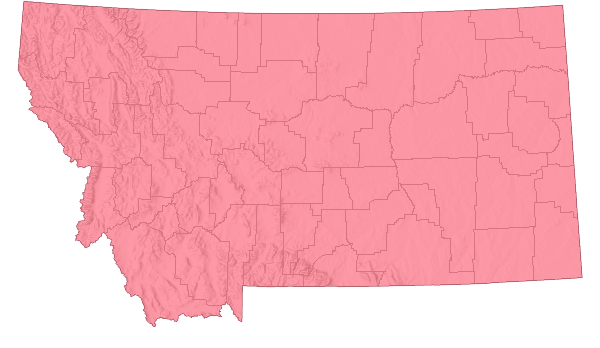
 Non-native
Non-native
Range Comments
Purple Loosestrife is native to Eurasia (Lesica 2012), and was first reported in North America in 1814 along the northeast coast (The Nature Conservancy 1987). It occurs throughout the northern U.S. and adjacent Canada(Lesica 2012).
For maps and other distributional information on non-native species see:
Nonindigenous Aquatic Species Database from the U.S. Geological Survey
Invasive Species Habitat Tool (INHABIT) from the U.S. Geological Survey
Invasive Species Compendium from the Centre for Agriculture and Bioscience International (CABI)
EDDMapS Species Information EDDMapS Species Information
Observations in Montana Natural Heritage Program Database
Number of Observations: 634
(Click on the following maps and charts to see full sized version)
Map Help and Descriptions
Relative Density
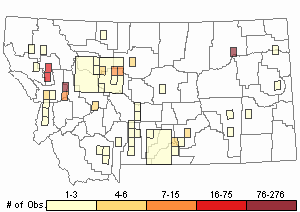
Recency
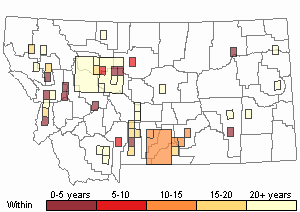
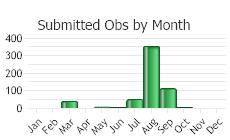
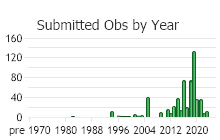
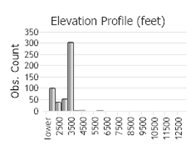 (Observations spanning multiple months or years are excluded from time charts)
(Observations spanning multiple months or years are excluded from time charts)
Habitat
Perennial and seasonal wetland habitats, especially where disturbed: marshes, pond margins, ditches, and streams in valleys (DiTomaso and Healy 2003; Lesica 2012). Plants tolerate a wide range of soil types (clay, sand, muck, and silt), but grow best in slightly acidic to neutral soils (The Nature Conservancy 1987; DiTomaso and Healy 2003). During the growing season, plants do not tolerate inundation (DiTomaso and Healy 2003). It usually grows in full sun, but can tolerate 50 percent shade (The Nature Conservancy 1987).
Ecology
Purple Loosestrife is competitive and colonial, often replacing native vegetation to form monocultures (DiTomaso and Healy 2003). Plants also displace native wildlife (DiTomaso and Healy 2003). It associates with cattail (
Typha latifolia), common reed (
Phragmites australis), cordgrass (
Spartina spp.), bulrush (
Scirpus spp.), and sedge (
Carex spp.) (The Nature Conservancy 1987).
Plants primarily reproduce by seed, and rarely by stem fragments. A single plant in one growing season can produce 2 million viable seeds (DiTomaso and Healy 2003). Dispersal occurs by water, human activities, and clinging to feathers, fur, or the feet of animals. Red-winged Blackbirds are known to eat seeds (The Nature Conservancy 1987). Humans disperse seeds that cling to their clothing and shoes (The Nature Conservancy 1987). However, most seeds disperse with water. Under cold storage seeds remain highly viable for 3 years; although, viability under natural conditions is unknown (DiTomaso and Healy 2003). Seeds germinate in acidic, alkaline, nutrient-rich, and nutrient-poor soils, but require temperatures ranging from 15 to 20 degrees Celsius (The Nature Conservancy 1987).
Infestations follow a pattern of establishment, maintenance at low numbers, and then large population increases when conditions are best (The Nature Conservancy 1987). Purple Loosestrife flourishes in wetlands that are disturbed or degraded, such as from hydrologic changes, bulldozing, siltation, shore manipulation, cattle trampling, or dredging (The Nature Conservancy 1987). Mudflats with an adjacent seed source can be quickly colonized by Purple Loosestrife. Populations eventually lead to monocultures. It displaces the native plants that provide food for wildlife, such as cattails and pondweeds (
Potamogeton spp.).
POLLINATORS The following animal species have been reported as pollinators of this plant species or its genus where their geographic ranges overlap:
Bombus fervidus,
Bombus ternarius,
Bombus bimaculatus,
Bombus griseocollis, and
Bombus impatiens (Plath 1934, Colla and Dumesh 2010, Colla et al. 2011, Williams et al. 2014).
Reproductive Characteristics
Within the inflorescence spike, several flowers grow from the axils of bracts. Each flower consists of a cylindric hypanthium covered in fine hairs (puberulent) of 4–5 mm long; sepals that are about 0.5 mm long with longer appendages in the sinuses; petals that are 7–11 mm long; and about 12 exserted stamens (Lesica 2012).
LIFE CYCLE (adapted from DiTomaso and Healy 2003):
Plants often turn red as they senesce and dieback by winter. In early spring sprouts grow from a broad, woody root crown. Seeds germination from spring to early summer. Plants sprouting from seeds develop taproots and float to the surface. Seedlings develop cotyledon (first-set) leaves that are ovate, 3-5 mm long, and glabrous (no hairs) with rounded leaf-tips, wedge-shaped leaf bases, and petioles of 1-2 mm. In addition, the stem is often purplish-spotted. Subsequent sets of leaves are similar, but larger and opposite. Seedlings can mature and flower in 8-10 weeks. Mature plants develop square to 5-angled stems. Plants flower from June through September. Flowers are pollinated by a variety of bees (Subfamily Megachilinae Apinae, and others) and butterflies (The Nature Conservancy 1987). Fruits (capsules) develop at different rates on the flowering stalk (The Nature Conservancy 1987). The persistent calyx tube surrounds each capsule. Capsules are narrowly ovoid to triangular, 3-4 mm long, and reddish-brown. Capsules open at their tips into halves to release numerous seeds. Seeds are flattened or 3-angled, often concave on one-side, and 0.5-1.0 mm long.
Management
Montana's Purple Loosestrife Task Force is led by Dave Burch who can be contacted at: (406) 444-3140 or
dburch@mt.govPurple Loosestrife was introduced from Eurasia for its ornamental and medicinal qualities, but escaped cultivation and has become a noxious weed in many portions of North America (DiTomaso and Healy 2003). Surveys to identify populations should be conducted in July and August when the plant is flowering (TNC 1987). The magenta colored flowers are easy to locate, and may be identifiable from aerial photographs.
CHEMICAL CONTROL
Glyphosate controls Purple Loosestrife (TNC 1987). On dry land trade names of RoundUp and Rodeo (developed by Monsanto) can be used. On water aquatic-labeled formulas must be used in combination with a non-ionic surfactant (TNC 1987). Herbicide applications should spot-spray (and not broadcast spray) plants because they are non-selective and will kill all plants. The safest method for applying a glyphosate herbicide is to cut stems to a height of about 6 inches and then paint or drip the cut surface with a 20-30 percent solution (TNC 1987).
Other recommendations for using glyphosate products include spraying plants after their peak bloom, spraying no more than 50 percent of the foliage to prevent damage to desirable plants, and to follow-up in the same growing season in order to assess effectiveness and control missed plants (TNC 1987). It is important to maintain strong competition from the desirable plant community or else Purpose Loosestrife will return to dominate (TNC 1987).
Herbicides designed to kill only broadleaf (dicot) plants, such as 2-4-D have also controlled Purple Loosestrife infestations. Broadleaf herbicides will not harm monocots, which includes all grasses, sedges and rushes (Juncus spp.). Herbicides such as 2,4-D can be applied to Purple Loosestrife in the spring after the plants have obtained 10-15 percent of their mature growth (TNC 1987). A combination of 2,4-D and Dicamba have also been used with good success (TNC 1987).
MECHANICAL CONTROL
Newly established plants should be hand-pulled before they develop flowers to ensure that seeds have not developed (DiTomaso and Healy 2003). This will prevent their spread. Root fragments that remain in the soil can re-sprout. All parts of the Purple Loosestrife plants must be bagged and removed from the site to ensure that they do not re-sprout (TNC1987). If possible, bagged plants should be tied and left in the hot sun to wither and die before disposing. It is important to not damage the desirable plant community in order to keep them competitive against Purpose Loosestrife’s will to survive (TNC 1987).
Wetlands should be seeded with native and desirable plant species. If Purple Loosestrife is mixed with desirable plants, then returning to help distribute seeds from desirable species may help. Otherwise a native seed mix of 5-9 species that are also approriate for the site should be developed and applied using best standards and practices.
BIOCONTROL
The Black-margined (Galerucella calmariensis) beetle, Golden Loosestrife (Galerucella pusilla) beetle, and Loosestrife Root-Weevil (Hylobius transversovittatus) were released in 1992 into some northern states (DiTomaso and Healy 2003). By 1994 the beetles were established in Washington, Oregon, Montana, and Idaho (DiTomaso and Healy 2003). As of 2017 in Lake County, Montana, Galerucella pusilla and Hylobius transversovittatus are thriving and inhibiting the plant’s abilities to develop viable seed heads (Lake County Weed District Coordinator, personal communication). These insects are moving on their own to other areas where Purple Loosestrife occurs (Lake County Weed District Coordinator, personal communication).
The loosestrife flower-feeding weevil (Nanophyes marmoratus) was released in 1994 into Washington, Oregon, Montana, and Colorado (DiTomaso and Healy 2003). However, its status in Montana is unknown (Lake County Weed District Coordinator, personal communication).
Useful Links:Montana Invasive Species websiteMontana Biological Weed Control Coordination ProjectMontana Department of Agriculture - Noxious WeedsMontana Weed Control AssociationMontana Weed Control Association Contacts Webpage.
Montana Fish, Wildlife, and Parks - Noxious WeedsMontana State University Integrated Pest Management ExtensionWeed Publications at Montana State University Extension - MontGuidesStewardship Responsibility
References
- Literature Cited AboveLegend:
 View Online Publication
View Online Publication Colla, S., L. Richardson, and P. Williams. 2011. Bumble bees of the eastern United States. Washington, DC: USDA Forest Service, Pollinator Partnership. 103 p.
Colla, S., L. Richardson, and P. Williams. 2011. Bumble bees of the eastern United States. Washington, DC: USDA Forest Service, Pollinator Partnership. 103 p. Colla, S.R. and S. Dumesh. 2010. The bumble bees of southern Ontario: notes on natural history and distribution. Journal of the Entomological Society of Ontario 141:39-68.
Colla, S.R. and S. Dumesh. 2010. The bumble bees of southern Ontario: notes on natural history and distribution. Journal of the Entomological Society of Ontario 141:39-68. Lesica, P., M.T. Lavin, and P.F. Stickney. 2012. Manual of Montana Vascular Plants. Fort Worth, TX: BRIT Press. viii + 771 p.
Lesica, P., M.T. Lavin, and P.F. Stickney. 2012. Manual of Montana Vascular Plants. Fort Worth, TX: BRIT Press. viii + 771 p. Plath, O.E. 1934. Bumblebees and their ways. New York, NY: Macmillan Company. 201 p.
Plath, O.E. 1934. Bumblebees and their ways. New York, NY: Macmillan Company. 201 p. Williams, P., R. Thorp, L. Richardson, and S. Colla. 2014. Bumble Bees of North America. Princeton, NJ: Princeton University Press. 208 p.
Williams, P., R. Thorp, L. Richardson, and S. Colla. 2014. Bumble Bees of North America. Princeton, NJ: Princeton University Press. 208 p.
- Additional ReferencesLegend:
 View Online Publication
View Online Publication
Do you know of a citation we're missing? Lehnhoff, E.A., L.J.Rew, J.M. Mangold, T. Seipel, and D. Ragen.2019. Integrated management of Cheatgrass (Bromus tectorum) with sheep grazing and herbicide. Agronomy 9, 315
Lehnhoff, E.A., L.J.Rew, J.M. Mangold, T. Seipel, and D. Ragen.2019. Integrated management of Cheatgrass (Bromus tectorum) with sheep grazing and herbicide. Agronomy 9, 315 Lesica, P., M.T. Lavin, and P.F. Stickney. 2022. Manual of Montana Vascular Plants, Second Edition. Fort Worth, TX: BRIT Press. viii + 779 p.
Lesica, P., M.T. Lavin, and P.F. Stickney. 2022. Manual of Montana Vascular Plants, Second Edition. Fort Worth, TX: BRIT Press. viii + 779 p. Montana Department of Agriculture (MDA). 2017. Montana Noxious Weed List. February. Helena, Montana.
Montana Department of Agriculture (MDA). 2017. Montana Noxious Weed List. February. Helena, Montana. Olliff, Tom, Roy Renkin, Craig McClure, Paul Miller, Dave Price, Dan Reinhart, and Jennifer Whipple. 2001. Managing A Complex Exotic Vegetation Program in Yellowstone National Park.
Olliff, Tom, Roy Renkin, Craig McClure, Paul Miller, Dave Price, Dan Reinhart, and Jennifer Whipple. 2001. Managing A Complex Exotic Vegetation Program in Yellowstone National Park.
- Web Search Engines for Articles on "Purple Loosestrife"





